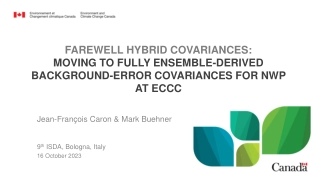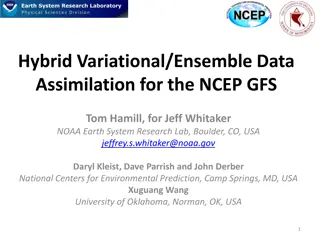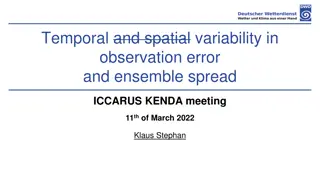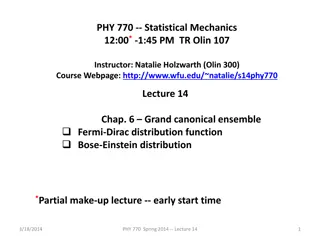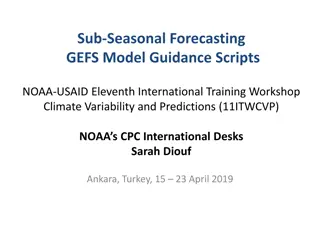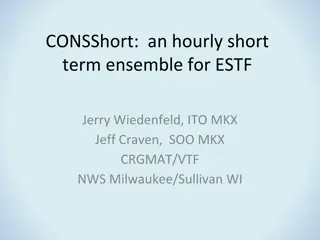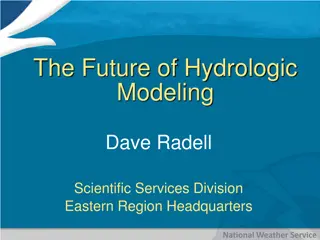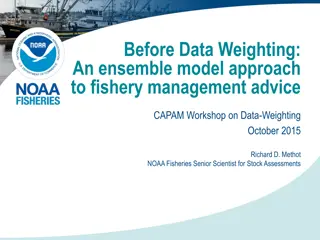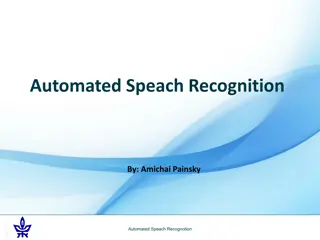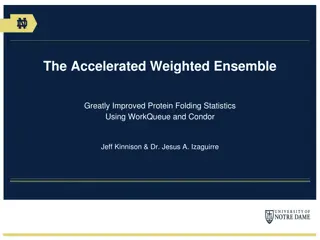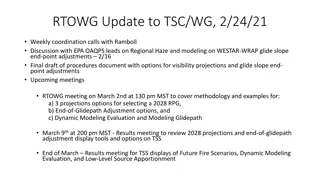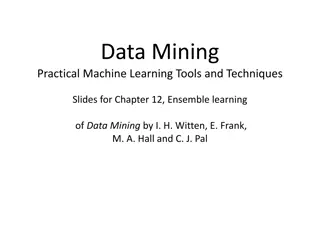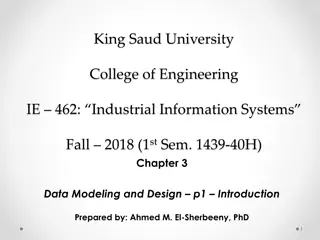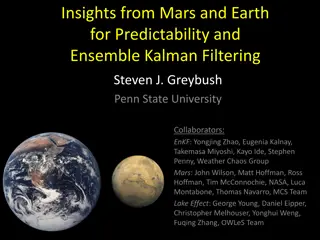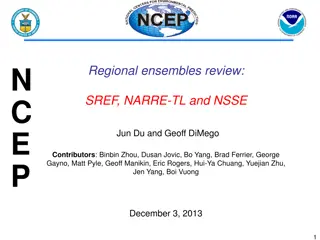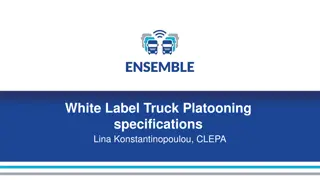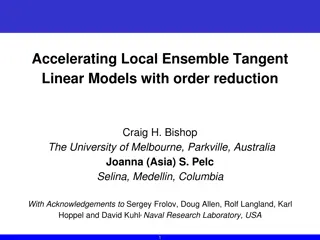Moving Towards Fully Ensemble-Derived Background-Error Covariances for NWP at ECCC
The transition from hybrid covariances to fully ensemble-derived background-error covariances for Numerical Weather Prediction (NWP) at Environment and Climate Change Canada (ECCC) is explored in this paper. It discusses the evolution of covariance formulations, the use of scale-dependent localizati
1 views • 20 slides
Overview of Army Modeling and Simulation Office
The U.S. Army Modeling and Simulation Office (AMSO) serves as the lead activity in developing strategy and policy for the Army Modeling and Simulation Enterprise. It focuses on effective governance, resource management, coordination across various community areas, and training the Army Analysis, Mod
1 views • 8 slides
Capacity Zone Modeling for Forward Capacity Auction 17 Results
This presentation unveils the Capacity Zone modeling calculations for Forward Capacity Auction 17 associated with the 2026-2027 Capacity Commitment Period by ISO-NE PUBLIC. It delves into boundary definitions, import-constrained zone modeling, and market rules guiding the assessments and modeling pr
0 views • 16 slides
Distribution Feeder Modeling and Analysis Overview
This document delves into the modeling, optimization, and simulation of power distribution systems, specifically focusing on Distribution Feeder Modeling and Analysis. It covers the components of a typical distribution feeder, series components, Wye-Connected Voltage Regulator modeling, and equation
0 views • 14 slides
Understanding Data Modeling vs Object Modeling
Data modeling involves exploring data-oriented structures, identifying entity types, and assigning attributes similar to class modeling in object-oriented development. Object models should not be solely based on existing data schemas due to impedance mismatches between object and relational paradigm
0 views • 17 slides
Evolution of Modeling Methodologies in Telecommunication Standards
Workshop on joint efforts between IEEE 802 and ITU-T Study Group 15 focused on information modeling, data modeling, and system control in the realm of transport systems and equipment. The mandate covers technology architecture, function management, and modeling methodologies like UML to YANG generat
1 views • 16 slides
Understanding Geometric Modeling in CAD
Geometric modeling in computer-aided design (CAD) is crucially done in three key ways: wireframe modeling, surface modeling, and solid modeling. Wireframe modeling represents objects by their edges, whereas surface modeling uses surfaces, vertices, and edges to construct components like a box. Each
1 views • 37 slides
Mathematical Modeling and Error Analysis in Engineering
Mathematical modeling plays a crucial role in solving engineering problems efficiently. Numerical methods are powerful tools essential for problem-solving and learning. This chapter explores the importance of studying numerical methods, the concept of mathematical modeling, and the evaluation proces
0 views • 10 slides
Introduction to Dynamic Structural Equation Modeling for Intensive Longitudinal Data
Dynamic Structural Equation Modeling (DSEM) is a powerful analytical tool used to analyze intensive longitudinal data, combining multilevel modeling, time series modeling, structural equation modeling, and time-varying effects modeling. By modeling correlations and changes over time at both individu
0 views • 22 slides
System Modeling and Simulation Overview
This content provides insights into CPSC 531: System Modeling and Simulation course, covering topics such as performance evaluation, simulation modeling, and terminology in system modeling. It emphasizes the importance of developing simulation programs, advantages of simulation, and key concepts lik
0 views • 28 slides
Understanding Object Modeling in Software Development
Object modeling is a crucial concept in software development, capturing the static structure of a system by depicting objects, their relationships, attributes, and operations. This modeling method aids in demonstrating systems to stakeholders and promotes a deeper understanding of real-world entitie
1 views • 65 slides
Join the Yinghua Academy Chinese Music Ensemble Today!
Exciting opportunity to join the Yinghua Academy Chinese Music Ensemble led by award-winning director Gao Hong. Play Chinese instruments in a supportive environment at a minimal fee of $50. Rehearse, perform, and learn the rich tradition of Chinese classical music. Enhance skills, make new friends,
0 views • 14 slides
Coupled Ocean-Atmosphere Modeling on Icosahedral Grids
Coupled ocean-atmosphere modeling on horizontally icosahedral and vertically hybrid-isentropic/isopycnic grids is a cutting-edge approach to modeling climate variability. The design goals aim to achieve a global domain with no grid mismatch at the ocean-atmosphere interface, with key indicators such
1 views • 21 slides
Hybrid Variational/Ensemble Data Assimilation for NCEP GFS
Hybrid Variational/Ensemble Data Assimilation combines features from the Ensemble Kalman Filter and Variational assimilation methods to improve the NCEP Global Forecast System. It incorporates ensemble perturbations into the variational cost function, leading to more accurate forecasts. The approach
0 views • 22 slides
Stochastic Coastal Regional Uncertainty Modelling II (SCRUM2) Overview
SCRUM2 project aims to enhance CMEMS through regional/coastal ocean-biogeochemical uncertainty modelling, ensemble consistency verification, probabilistic forecasting, and data assimilation. The research team plans to contribute significant advancements in ensemble techniques and reliability assessm
0 views • 28 slides
Fire and Smoke Modeling Evaluation Effort (FASMEE) Overview
FASMEE is a collaborative project aimed at assessing and advancing fire and smoke modeling systems through critical measurement techniques and observational data. Led by key technical leads, FASMEE focuses on diverse modeling areas such as fire growth, effects, coupled fire-atmosphere behavior, smok
5 views • 30 slides
Insights on Observation Error, Ensemble Spread, and Radar Reflectivity in Meteorological Analysis
Explore topics such as temporal and spatial variability in observation error, ensemble spread analysis, baseline observations at DWD, estimation of observation errors, and radar reflectivity analysis. Gain insights into data processing and interpretation in meteorological studies.
0 views • 26 slides
Grand Canonical Ensemble in Statistical Mechanics: Fermi-Dirac Distribution
Exploring the Fermi-Dirac distribution function and the Bose-Einstein distribution in the context of the grand canonical ensemble for non-interacting quantum particles. The lecture delves into the impact of particle spin on energy spectra, enumeration of possible states, self-consistent determinatio
0 views • 33 slides
NCEP GEFS Sub-Seasonal Forecasting Exercise
In this exercise, you will generate NCEP GEFS deterministic week 1 and week 2 forecasts for precipitation and temperature anomaly. The practical steps include downloading the necessary data and scripts, extracting the files, and accessing the GEFS model guidance. This exercise focuses on understandi
0 views • 12 slides
Subarea and Highway Corridor Studies: Travel Demand Modeling and Refinements
In this lesson, we delve into subarea and corridor studies focusing on travel demand model refinements, highway network coding, corridor congestion relief, and trip assignment theory. Subarea modeling plays a crucial role in forecasting travel within smaller regions with detailed traffic patterns, t
1 views • 45 slides
Hourly Short-Term Ensemble for Milwaukee/Sullivan, WI
Observations and models are blended to create an hourly short-term ensemble forecast for Milwaukee/Sullivan, WI. The ensemble includes elements like temperature, dew point, wind, precipitation, and more, providing valuable data for up to 24 hours ahead. Various models and observations are used in th
0 views • 37 slides
Essential Steps for Setting up a Modeling Study
Ensure clarity on modeling goals and uncertainties. Select sample areas strategically based on interest and available data. Determine appropriate resolution for modeling. Define variables to model and validate the model effectively. Assess sample data adequacy and predictor variables availability. E
0 views • 9 slides
Water Storage Tanks Hydraulic Modeling and Water Quality Considerations
This presentation by Justine Carroll, P.E., Project Manager, focuses on the hydraulic modeling and water quality considerations related to water storage tanks. It covers topics such as water age evaluation, steady state modeling, extended period simulations, pump controls, demand patterns, EPS verif
0 views • 34 slides
Advancing Computational Modeling for National Security and Climate Missions
Irina Tezaur leads the Quantitative Modeling & Analysis Department, focusing on computational modeling and simulation of complex multi-scale, multi-physics problems. Her work benefits DOE nuclear weapons, national security, and climate missions. By employing innovative techniques like model order re
0 views • 6 slides
Flexible Framework for Stormwater Lids Modeling
A new flexible framework for forward and inverse modeling of stormwater lids is presented. It includes governing equations, hydraulic and contaminant transport, numerical methods, and demonstration cases for various green infrastructure components. The importance of different processes in modeling i
0 views • 20 slides
Innovative Approach for f5C Detection using Ensemble Neural Networks
Epigenetic modification 5-formylcytidine (f5C) plays a crucial role in biological processes. This study introduces f5C-finder, an ensemble neural network model, utilizing multi-head attention for precise f5C identification. By combining five distinct features extraction methods into an ensemble lear
0 views • 23 slides
Advancements in Hydrologic Modeling for Enhanced Predictions
Explore the future of hydrologic modeling with a focus on distributed models, data assimilation, ensemble forecasts, and verification. Discover the potential benefits of continued research in physically based models for more accurate forecasts in various conditions. Uncover challenges facing hydrolo
0 views • 23 slides
Ensemble Modeling in Fishery Management: Insights from CAPAM Workshop
Structural uncertainty dominates fishery management decisions as discussed in the CAPAM workshop on data-weighting. The workshop highlighted the importance of ensemble modeling, protocols for ensemble membership, and communication of ensemble distributions for effective decision-making. Various case
0 views • 17 slides
Understanding Automated Speech Recognition Technologies
Explore the world of Automated Speech Recognition (ASR), including setup, basics, observations, preprocessing, language modeling, acoustic modeling, and Hidden Markov Models. Learn about the process of converting speech signals into transcriptions, the importance of language modeling in ASR accuracy
0 views • 28 slides
Accelerated Weighted Ensemble for Improved Protein Folding Statistics
The Accelerated Weighted Ensemble (AWE) approach addresses the challenges faced by traditional molecular dynamics (MD) simulations in generating statistically significant kinetic data for protein folding. By utilizing methods such as WorkQueue and Condor, AWE enhances efficiency and accuracy in stud
0 views • 14 slides
Update on Modeling and Coordination Discussions
Weekly coordination calls with Ramboll and discussions with EPA OAQPS leads focused on Regional Haze and modeling adjustments. Final draft of procedures document with visibility projections and glide slope adjustments. Upcoming RTOWG meetings covering methodology, projections, and modeling evaluatio
0 views • 5 slides
Ensemble Learning in Data Mining: Tools and Techniques
Ensemble learning in data mining involves combining multiple models to improve predictive performance. Techniques such as bagging and boosting are utilized to create a single, more accurate model from diverse experts. The bias-variance decomposition is employed to analyze the impact of training set
0 views • 15 slides
Importance of Data Modeling in Industrial Information Systems
Introduction to data modeling and design in Industrial Information Systems at King Saud University College of Engineering. The chapter covers the significance of data modeling, capturing data characteristics, structural information, and the role of databases and DBMS. Data modeling fills crucial gap
0 views • 51 slides
Insights from Mars and Earth for Predictability with Ensemble Kalman Filtering
A collaborative effort between Penn State University and various teams explores the predictability of Martian and Earth weather phenomena using ensemble Kalman filtering. A comparison of key characteristics between Earth and Mars is provided, shedding light on their variable atmospheres and climates
0 views • 31 slides
NCEP Regional Ensembles Review Summary
Completed WCOSS transition of both SREF and NARRE-TL in production, with upgrades and fixes for improved ensemble forecasting. Delivered interim upgrade packages for SREF, planned future upgrades, and introduced an experimental NCEP Storm-Scale Ensemble. Performance evaluation in a heavy rain event
0 views • 20 slides
Mega-Modeling for Big Data Analytics
Mega-Modeling is a comprehensive approach that encompasses model construction, evaluation, composition, evolution, and search to address challenges in various areas such as social and economic resilience, health, transportation, and energy management. The pillars of Mega-Modeling include Model-Drive
0 views • 14 slides
Overview of White Label Truck Platooning Specifications
White Label Truck Platooning involves driving trucks at short inter-vehicle distances for extended periods, creating a system of interconnected systems with specific requirements. The driver cannot be solely responsible for immediate intervention during critical events, necessitating a unique automa
0 views • 8 slides
Grandpa Dan and Other Characters' Musical Ensemble
Ensemble featuring Grandpa Dan on the bass, Nicki on the glockenspiel, various other characters playing unique instruments like the guiro, finger cymbals, and more, all coming together to create a harmonious symphony. Enjoy the orchestration of different sounds and characters in this delightful perf
0 views • 9 slides
NetLogo - Programmable Modeling Environment for Simulating Natural and Social Phenomena
NetLogo is a powerful and versatile programmable modeling environment created by Uri Wilensky in 1999. It allows users to simulate natural and social phenomena by giving instructions to multiple agents operating independently, making it ideal for modeling complex systems evolving over time. NetLogo
0 views • 7 slides
Accelerating Local Ensemble Tangent Linear Models
This research focuses on accelerating Local Ensemble Tangent Linear Models with order reduction, exploring methods, results, and implications for advancing numerical modeling in atmospheric and oceanic systems. The study addresses challenges in maintaining accurate TLMs and adjoints for coupled mode
0 views • 21 slides
